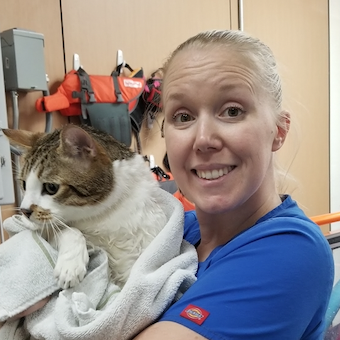Over 60% of veterinarians in the U.S. are women, and about the same percentage of women in the U.S. will have a child in their lifetime.
So, how can the veterinary industry better support mothers? We teamed up with the DVMoms community to find out what benefits would most help them as they navigate motherhood.
What benefits could help mothers thrive in the veterinary workplace?
Paid, short-term disability for new mothers
Under the Family and Medical Leave Act (FMLA), employees at companies with over 50 employees must be allowed up to 12 weeks of unpaid, job-protected leave per year for any of the following reasons:
- For the birth and care of the newborn child of an employee;
- For placement with the employee of a child for adoption or foster care;
- To care for an immediate family member (i.e., spouse, child, or parent) with a serious health condition; or
- To take medical leave when the employee cannot work because of a serious health condition.
The keyword here: unpaid.
Not paying your employees during their maternity leave, while not required by law, is simply unacceptable.
To the DVMoms community, paid short-term disability is a must for new mothers. In terms of length, their recommendation is at least 10 - 12 weeks, minimum.
Protected pumping breaks
Veterinary workplaces must be cognizant of new mothers’ needs as they come back to work after maternity leave. One of those considerations is pumping breaks.
According to Willow, the average stages for pumping can be broken down by months:
- Newborns (first 1-6 weeks): 8-10 times/day
- First 3 months: 5-6 times/day
- 6 months: 4-5 times/day
- 12 months: 1-2 times/day
When prepping for a mother to come back from maternity leave, make sure to protect pumping breaks in their schedule — and not allow them to be overbooked.
Flexible schedule (with no guilt)
Once kiddos get a bit older, they’ll start having their own schedules with daycare, school, and activities.
Veterinary workplaces must work proactively with the mothers they employ and give them flexibility in their schedules to be there for their children.
Additionally, workplaces should never make mothers feel guilty for having a circumstance happen out of their control (like a sick kid, school closing, etc.)
One of the members of the DVMoms community even noted that having a child-focused space in the workplace is helpful, so they can bring their child to work with them.
Childcare stipends
While not commonplace in the veterinary field yet, many industries have implemented childcare stipends into their benefits packages.
According to the U.S. Department of Labor, yearly childcare prices range from $5,357 for school-age home-based care in small counties to $17,171 for infant center-based care in very large counties.
Offsetting some of that cost can encourage mothers to stay in the workforce by making it economically feasible for them to continue working.





.gif)


